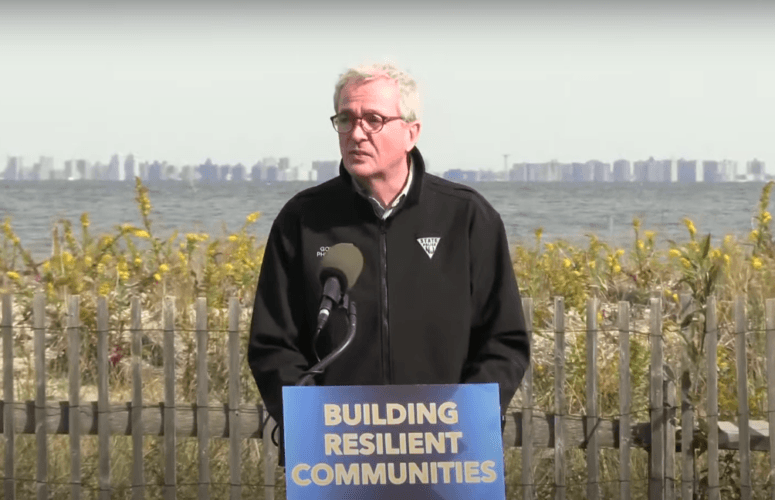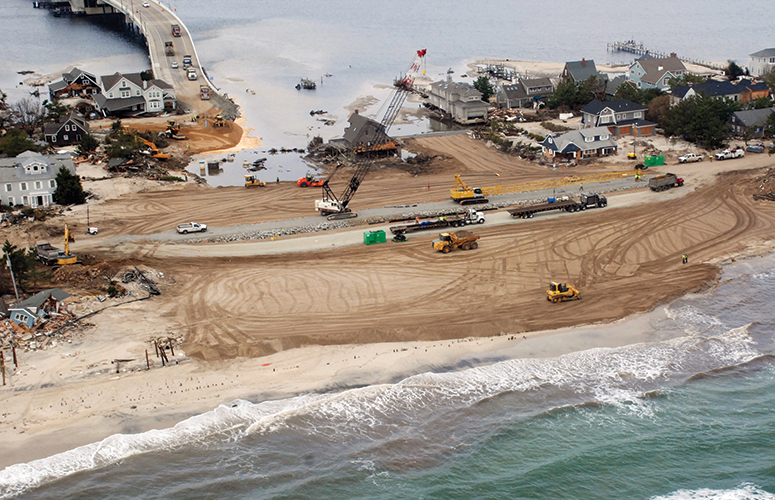
10 Years Since Sandy, Murphy Highlights Resiliency Efforts
On Oct 28, 2022Today, nearly 10 years after Superstorm Sandy ravaged the Garden State, Gov. Phil Murphy toured the Port Monmouth Flood Protection project in Monmouth County to commemorate the anniversary of the storm and to highlight more than $10 billion in federal investments in housing, economic, and flood resilience infrastructure aimed to help rebuild the state and bolster resilience to future storms.
The Port Monmouth Flood Protection project is a hurricane and storm damage reduction project involving the construction of levees, floodwalls, a tide gate, a road closure gate, drainage improvements, dunes, and beach renourishment along the Raritan Bay and Sandy Hook Bay in the Port Monmouth area of Middletown Township. Port Monmouth was devastated by Sandy when it hit in 2012, as surge and tidal flooding damaged more than half of the local housing units in the town.
According to Murphy, the project was in the works for about 20 years, but moved forward urgently post-Superstorm Sandy. Led by the U.S. Army Corps of Engineers and the New Jersey Department of Environmental Protection (DEP), the project is estimated to cost about $265 million and expected to be completed by April 2025.
“A decade ago tomorrow, our state experienced the greatest natural disaster in its history, which decimated the Jersey Shore and caused major damage to many beloved communities across New Jersey,” said Murphy. “Today, we remember the at least 35 lives lost directly caused by the storm, the more than 300,000 destroyed properties that left tens of thousands of residents with no homes, and the nearly 3 million residents without power for days. As we remember the past, we must also look to our future. A future in which New Jersey is more resilient to storms thanks to the flood protection measures that we have taken since that tragic day 10 years ago.”
Lt. Governor Sheila Oliver added that while the recovery is still ongoing, in the 10 years since Sandy, the state has accomplished a great deal.
“Thousands of people’s homes along the bays, shore, and waterways have been reconstructed and elevated to protect them against future flooding. However, Gov. Murphy and I understand New Jersey must be proactive in preparing for the next storm,” said Oliver. “This is why the state has allocated so many resources to resiliency initiatives like the Port Monmouth Flood Protection Project, which are a proven way to protect lives and properties from destruction.”
The Port Monmouth project is among several other Army Corps and DEP-led resilience projects actively being built in New Jersey.
The first phase of a massive resilience project consisting of levees, floodwalls, tides gates, and pump stations providing protection for Union Beach along Raritan Bay is moving forward, with construction scheduled to begin in March 2023. Once fully constructed, the Union Beach Resiliency project will surround low-lying, vulnerable areas with infrastructure that will help protect properties and lives from future storms. The overall project is expected to cost about $395 million and encompasses about 1.8 square miles.
Design is also currently underway for a project involving the Borough of Highlands. The Army Corps and the DEP are working with the community to install a floodwall, levees, pump station, road closure gate and interior drainage within the 0.7-square-mile borough. This project is estimated to cost about $198 million.
Major funding was made available for these projects at the federal level.
Over the past decade since Sandy, the DEP has worked with the Army Corps to invest approximately $2 billion for coastal and flood protection projects focused along the shore. In addition to the Port Monmouth, Union Beach, and Highlands projects, other Army Corps-funded projects include:
- $96.8 million beach and dune construction project in Cape May County (encompassing beaches in southern Ocean City, Upper Township, and Sea Isle City) that is complete.
- $140.4 million project to construct beaches and infrastructure in Monmouth County (Loch Arbour, Allenhurst, Deal, and Long Branch) that is complete.
- $159.9 million beach and dune construction project covering 12.7 miles of beach on Long Beach Island that is complete.
- $39.3 million seawall and boardwalk project along Absecon Inlet that is complete in Atlantic City.
- $59.3 million beach and dune construction project on Absecon Island (renourish Atlantic City and Ventnor and initial construction Longport and Margate) that is complete.
- $131.4 million beach and dune project for Northern Ocean County (for all towns from Point Pleasant Beach to Berkeley Township) that is complete.
- $11.4 million project to initially construct beach berm along Oakwood Beach in Elsinboro Twp. along the Delaware River that is complete.
The Army Corps also completed the repair and restoration of all of the pre-Sandy coastal protection projects along the Monmouth, Ocean, Atlantic and Cape May counties coastline at a cost of more than $200 million.
In addition to immediate post-Sandy repairs, the Army Corps has also completed more than $300 million in periodic beach nourishment since the completion of Sandy-related work.
These large-scale projects are in addition to the many more emergency response and resiliency projects completed across the state that, in total, invested more than $10 billion to rebuild New Jersey.
“Superstorm Sandy remains a defining moment in New Jersey history,” said DEP Commissioner Shawn LaTourette. “Sandy called on us to build greater resilience for all New Jersey communities, and we have come a long way. Today, our coastal communities are better protected by miles of engineered dunes, living shorelines, continually replenished beaches, and flood resistant infrastructure.”
To access more business news, visit NJB News Now.
Related Articles:





